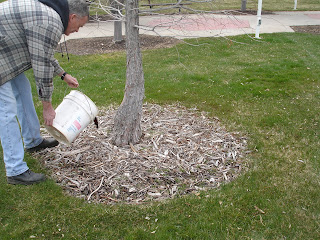For years hybridizers have tried to create the elusive, truly black rose. The idea was to be the first to develop this highly sought after flower, which would earn that fortunate person enough money to purchase a small island in the Pacific (something about the size of Australia). There is a dark-purple rose that some people (who may be slightly color blind) have called black; but, in reality, nothing even comes close.
That is until now! I discovered this rare rose recently, and I didn’t even have to do any weird hybridizing stuff. I simply walked out to the Rose Garden at the Ogden Botanical Gardens, and “poof”, there it was. In fact, just about every rose we have has turned into a black rose. Wait, we are talking about the stems being black aren’t we? What? You mean the color of the blossom is black? Never mind….
As several people have noticed, many roses in our area became bored with the normal green canes, and decided to try a new look…black. Although the canes have a decidedly different appearance, the bad news is they probably won’t bloom very well this year. Okay, I think…no, I am pretty sure they are dead. (The idea was to soft peddle this news by throwing in a little humor. I must admit it is, indeed,
little, especially when we are talking about our beloved roses.)
Sad as it may seem, many roses throughout northern Utah have fallen victim to a northern Utah fall weather “special”. Late last November through early December, just as we were recovering from our Thanksgiving feast, the weather went from a nice balmy 60+ degrees to about -178 degrees F. Well, actually, it may have felt that cold, but it did dip down to almost 0 degrees in a matter of a couple of days, which made many roses extremely unhappy.
As all rose growers know, this is not the smartest plant in the landscape. Beautiful, yes, but pretty dumb on the plant intelligence scale (I think in rates about a minus 7). Most plants figure out when it is getting cold, begin dropping their leaves, and progress into dormancy about mid to late October. Roses, however, forget winter follows this cold spell, and continue growing and trying to look pretty until about January.
Most years, this is not a problem. But, when the temperature drops quickly from a nice growing temperature to well below freezing, like it did this past fall, the roses do not have enough time to acclimate. Plants need a slow cooling process of about two to six weeks to prepare for winter. They drop their leaves, move water and energy out of the stems and into the roots. As the water leaves the cells in the stems they harden, and are ready for cold temperatures. This explanation simplifies the process, but, basically, it’s too much cold too fast which equals dead roses.
When we get deep, freezing temperatures before the plant is ready, it compromises the integrity of the cells. This is similar to putting fresh strawberries in the freezer. They are nice and firm going in, but the freezing action of expanding water (ice) punctures the cell walls, and all the guts and important stuff leaks out. In other words, the strawberry dies just like our roses did.
I wish there was something we could do about it now, but, in reality, it’s too late. If the cane is black clear to the ground, the roots may still be alive, but the good part of the rose is dead. You will get growth, but it will not be the pretty rose you remember because the rose’s rootstock will take over. Bite the bullet and just replace it. If any green remains at the base of the rose, say about 4 to 6 inches high on the cane, the rose will eventually recover and should be fine.
Regardless, remove all the blackened canes which may include removing the whole rose. The good news in all this is we now have an opportunity to plant some of the cool new roses in our landscapes. I might recommend avoiding the black varieties…
Here at the Ogden Botanical Gardens we also lost roses. In fact, we figure about 300 are gone. Sadly, the roses are a major focal point of the Gardens, and a source of beauty and pride for the city. Because we are a non-profit organization, this puts a huge financial burden on us. With this in mind, we are setting up a fund to buy and replant our beautiful rose garden. We calculate it will cost us about $10,000 to bring the Rose Garden back to its pre-freeze condition. If you would like to help, please contact us at either the Ogden Botanical Gardens (1750 Monroe Boulevard in Ogden at 801-399-8080, Tuesday or Thursday, 12:30-3:30), or the Weber County Utah State University Extension Office (1181 North Fairgrounds Drive, in Ogden at 801-399-8201). Thanks for your help.

























